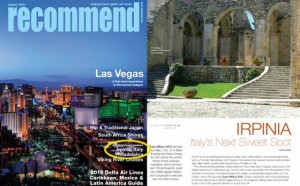Irpinia, Italy’s Next Sweet Spot
09.01.2015, La promozione turistica (Tradotto da Federico Lenzi dal sito www.recommend.com)
 La Campania è conosciuta per i suoi paesaggi sorprendenti e d’intensa malinconia, isole leggendarie, e siti archeologici come Pompei, Ercolano e Paestum. Eppure, il vero tesoro della Campania può essere nell’area interna chiamata Irpinia, situata nella provincia di Avellino in Italia.
La Campania è conosciuta per i suoi paesaggi sorprendenti e d’intensa malinconia, isole leggendarie, e siti archeologici come Pompei, Ercolano e Paestum. Eppure, il vero tesoro della Campania può essere nell’area interna chiamata Irpinia, situata nella provincia di Avellino in Italia.
Questo paradiso vinicolo, situato a un’ora di auto a est di Napoli, ha origine ai tempi della Magna Grecia circa 3.000 anni fa. Il presidente della “Camera di Commercio di Avellino”, Costantino Capone, spera che questa antica associazione catapulti l’Irpinia nei circuiti turistici internazionali in occasione della prossima “Expo”. Nel corso di una discussione con i partecipanti all’”educational tour” svoltosi di recente, si è suggerito di associare l’Irpinia alla Costiera Amalfitana; la maggior parte degli operatori prevedono di fare proprio questo.
“Dolce campania”
L’Irpinia, una terra che è sia benedetta e sia maledetta da un’abbondanza di aree vulcaniche: in modo benevolo per i vigneti, ma ancora soggetta a terremoti, uno si è avuto di recente, nel 1980; è nota per le sue cantine. Questo tour delle cantine parte dalla nuova “Cantina Marianna Grottolella”, gestita da un padre e da una figlia dal 1996, per arrivare alla cantina più antica della regione, la “Mastroberardino” di Atripalda famosa in tutto il mondo con il ristorante “Morabianca” al “Radici Resort & Golf”. Altre importanti cantine sono i “Feudi di San Gregorio” a Sorbo Serpico con il suo moderno ristorante stellato Michelin, “Marenna”, immerso tra i vigneti; “Caggiano” di Taurasi; “Molettieri” di Castelfranci; e la “Quintodecimo Moio” a Mirabella Eclano. E’ una terra di formaggi, salumi, tartufi, castagne e, va da sé, vini premiati.
Oltre all’ assaggio di grandi vini lungo la strada, abbiamo anche avuto l’opportunità di incontrare l’esperto di tartufo: il signor Lenzi del comune di Bagnoli Irpino, paese che fa parte del “Parco Regionale dei Monti Picentini”. Sotto gli sprazzi di cielo azzurro tra edifici di due o tre piani nei vicoli stretti, abbiamo imparato a conoscere il tartufo bianco e nero, e con i migliori cercatori-suini o cani-siamo andati a cercare fuori paese l’oro nero. Tutto questo è stato seguito da un generoso assaggio di ricotta al tartufo.
Mentre abbiamo apprezzato con la degustazione un pezzo di paradiso, i bagnolesi (bahn-yo-Lazee), come la gente di Bagnoli Irpino si chiama, si stavano preparando per la festa della Madonna . Durante il nostro viaggio attraverso la regione, abbiamo continuato a imbatterci in giorni di festa. Infatti, in autunno, le vendemmie dominano la stagione, così come la “Festa delle castagne e del tartufo nero” alla fine di ottobre con l’anteprima dei formaggi locali nella piazza “Leonardo Di Capua”.
Sostiene Stefania Gargone, un principale dell’operatore “Settimo Cielo Tours”, che ha organizzato il programma:”C’è una festa quasi ogni giorno dell’anno e il calendario estivo è ricco di eventi religiosi colorati … si potrebbe letteralmente passare da una festa ad un’altra degustando piatti completamente diversi in ciascuno di essa. “
Non appena ha detto questo, ci siamo letteralmente imbattuti nella “Sagra de Maialino”, la festa del maialino in Grottolella, dove abbiamo provato la “montanara”: un po ‘di pizza fritta che sta nel palmo della tua mano, ed è leggermente baciata da pomodori e da una spolverata di formaggio.
All’interno dell’area Taurasi-Avellino, i visitatori viaggiano tra castelli e cantine, e aprono le porte ad alcune delle cantine più particolari: Caggiano, Mastroberardino, Feudi di San Gregorio, e Galardi. Tutte producono una grande varietà di premiati bianchi aromatizzati e fruttati, rossi intensi.
“Il gusto della regione inizia nel naso, scivola giù per la gola e si fa strada per la memoria”, ha detto il maestro enologo Salvatore Molettieri, descrivendo come il vino va degustato e valutato. “Deve raggiungere la temperatura del vostro corpo e poi si saprà se questo vino è per voi o forse per qualcun altro … mai continuare a bere se brucia la gola, anche per un attimo.”
E nei vigneti tentacolari di “Mastroberardino”, abbiamo incontrato i veri “custodi del vitigno”: i cespugli di rose piantate all’inizio di ogni filare di uva come esche per le malattie prima che attacchino i vitigni.
ristoranti e strutture ricettive
Gli amanti del cibo e del vino non devono essere guru gastronomici per godere dei programmi di nuova concezione in giro per l’ Irpinia. Tutti i padroni di casa sono accoglienti, proprio come meravigliosi insegnanti che incoraggiano gli studenti ad associare le proprie passioni con l’uva, il formaggio, i tartufi e le castagne. E in ciò sono spettacolari.
La tendenza al “farm-to-table” non è nuova qui. Il pranzo al “Nonna Pina” di Bagnoli Irpino è costituito da prodotti che vengono coltivati proprio sotto la terrazza dove viene servito. Comprende il salame, i formaggi, il vino, i tartufi e il grano per la pasta, nati nel raggio di un chilometro da dove si pranza. Allo stesso modo, nel ristorante “Marenna”, circondato dalle lussureggianti colline dolci della vigna “Feudi”, fondata dalla squadra marito-e-moglie di Enzo Ercolino e Mirella Capaldo a metà degli anni 1980, si accoppiano tutti i pasti con i vini provenienti direttamente dai loro vigneti .
A seguito del terremoto del 1980, Rocca San Felice è stata ricostruita dalle pietre originali pezzo per pezzo. Oggi, è sede di un eccezionale ristorante che dispone di un piccolo museo a “La Ripa”. Allo stesso modo, le cantine di Antonio Caggiano sono state sottoposte ad un importante restauro dopo lo stesso evento catastrofico ed è stato aggiunto un museo sotteraneo.
Castelvetere Sul Calore, intanto, è un villaggio storico la cui comunità ha abbracciato un concetto (quasi impossibile da tradurre letteralmente). La gente del posto ha ripreso gli edifici storici per creare una forma insolita di ospitalità “Albergo Diffuso”: 17 camere moderne in un dedalo di vecchi edifici in pietra, una caffetteria, uno spazio di incontro a pochi metri l’uno dall’altro e di un campanile, campanile, proprio nel cuore della città. L’esperienza rende un senso di autenticità.
Morra de Sanctis è un borgo medievale che ha anche trasformato parte del suo castello in un “bed and breakfast” che comprende anche uno spazio d’ incontro e di ampie sale da pranzo con menu regionali. Ulteriore sistemazione più convenzionale, hotel a quattro stelle, è l’”Hotel de La Ville”, che dispone di un bel giardino per pranzare o semplicemente per rilassarsi.
I partecipanti con solo un’infarinatura d’ informazioni all’inizio di questa incredibile avventura, disegnata dai principali di “Settimo Cielo” con la loro conoscenza approfondita della regione, sono partiti con il dono della conoscenza sulle papille gustative. Sono stati nella terra in cui tutto questo è cresciuto e hanno dato una sbirciatina a uno stile di vita che deve ancora svanire, fortunatamente per noi.
L’”Expo Milano 2015” si terrà dal 1 maggio al 31 ottobre a Milano. “Nutrire il pianeta, energia per la vita” sarà il tema centrale di questa esposizione universale, che ospiterà più di 130 partecipanti, coprendo un milione di metri quadrati, e si prevede di accogliere oltre 20 milioni di visitatori.
Cosa dicono le agenzie di viaggio …
“La particolarità è che tutto questo ottimo cibo e incredibile vino sono disponibili a un costo abbordabile, con qualità superiore, rispetto ad altre aree”, afferma “Scelta Europa” di Rosario Mariani. Lisa Goldman di “Tour de Forks”, aggiunge che, “I nostri clienti sono i buongustai appassionati di cibo e di vino che vogliono esplorare nel mondo tutte le sue meraviglie commestibili. Siamo convinti che è possibile catturare l’essenza stessa di una destinazione per approfondire la sua cucina. Ci sentiamo [quest’area] è d’aggiungere. Lascia che sia il tuo unico obiettivo perfetto; è un luogo ideale per indulgere nella sua bellezza, di cibo e vini. “
______________________________
L’articolo nella lingua originale
Irpinia, Italy’s Next Sweet Spot
Known for its astonishing landscapes and deep blues, fabled islands, and archaeological sites such as Pompeii, Herculaneum and Paestum, Campania’s true treasure may be the land-locked area called Irpinia, located within the province of Avellino in Italy.
This wine-producing paradise, nestled about an hour’s drive east of Naples, dates back to the Magna Grecia some 3,000 years ago. And it is this ancient association that the president of the chamber of commerce, Constantine Capone in Avellino, is hoping will catapult Irpinia onto the tourism map at the upcoming Expo Milano 2015. During a discussion with those participating on the educational tour I recently tagged along on, he suggested pairing Irpinia with the Amalfi Coast; most of the operators planned to do just that.
“dolce campania”
Irpinia, an area that is both blessed and cursed by rich volcanic earth so benevolent for vineyards yet prone to earthquakes, one as recently as 1980, is known for its wineries. These wineries trail from the new Cantina Marianna Grottolella, run by a father and daughter since 1996, to the oldest winery in the region, the world-famous Mastroberardino of Atripalda with the Morabianca restaurant at the Radici Resort & Golf. Other vineyard highlights include the Feudi di San Gregorio of Sorbo Serpico with its modern Michelin-starred restaurant, Marenna, nestled among the vineyards; Caggiano of Taurasi; Molettieri of Castelfranci; and the Quintodecimo Moio in Mirabella Eclano, a land of cheese, salami, truffles, chestnuts and, it goes without saying, award-winning wines.
In addition to sampling grand wines along the way, we also had the opportunity to meet with truffle expert Signor Lenzi in the town of Bagnoli Irpino, which is part of the Picentini Mountain Park. Beneath arcs of blue stars strung between 2- and 3-story buildings above the narrow alleys, we learned about black and white truffles, and which make the best foragers—pigs or beagles—to scout out the black gold. All of this was followed by a generous sampling of truffle butters.
Tour participants like Rosario Mariani, principal at Europe by Choice, were inspired on the spot to coin the phrase “Dolce Campania” to market his program to Irpinia in 2015. Lisa Goldman, marketing v.p. of Tour de Forks said, “This untouristed region is a gem and the amazing DOCG wines (Aglianico, Fiano di Avellino, Greco di Tufo and Falanghina) are only half the story, the other is its food.”
While we enjoyed tasting a little bit of heaven, the Bagnolese (bahn-yo-lazee), as the Bagnoli Irpino locals are called, were preparing for the feast of La Madonna della Grazia. During our journey through the region, we kept running into such feast days. In fact, by autumn, thevendemmias or grape harvests dominate the season, as does the Feast of the Chestnuts and Black Truffles at the end of October with a preview of the local cheeses in the Piazza Leonardo Di Capua.
Said Stefania Gargone, a principal of the ground operator, Settimo Cielo Tours, or Seventh Heaven Tours, who organized the program, “There is a feast day just about every day of the year and the summer calendar is packed with colorful religious events…you could literally go from one feast to another tasting totally different dishes at each one.”
No sooner did she say this that we literally bumped into the Sagra de Maialino, the feast of the little pig in Grottolella, where we sampled montanara, a little fried pizza that fits in the palm of your hand and is lightly kissed by tomatoes and a dusting of cheese.
Within the Taurasi area of Avellino, visitors trip over castles and wine cellars, and open doors to some of the most peculiar cellars at Caggiano, Mastroberardino, Feudi di San Gregorio, and Galardi, all producing a great variety of award-winning zesty whites and fruity, intense reds.
“The taste of the region begins in the nose, trickles down the throat and makes its way to your memory,” said master winemaker Salvatore Molettieri, describing how wine should be tasted and evaluated. “It must reach your body’s temperature and then you will know if this wine is for you or maybe for someone else…never keep drinking if it burns your throat even for a moment.”
And in the sprawling vineyards of Mastroberardino, we encountered the real “guardians of the grape,” a reference to the rose bushes planted at the start of each row of grapes as decoys for diseases before they attack the vines, thus affording vintners time to protect the vines.
dining and accommodations
Food and wine lovers need not be gastronomic gurus to enjoy the newly developed programs around Irpinia. All the hosts are welcoming and more like wonderful teachers encouraging students to pair their own passions with the grapes or the cheese, the truffles or the chestnuts. And the settings are spectacular.
The farm-to-table trend is nothing new here. Lunch at Nonna Pina’s in Bagnoli Irpino consists of products that are grown just below the terrace where lunch is served—that would include the salami, the cheeses, the wine, the truffles and the wheat for the pasta, originated within a kilometer from where one dines. Likewise, the aforementioned Marenna restaurant, surrounded by the lush gentle hills of the Feudi vineyard that was founded by the husband-and-wife team of Enzo Ercolino and Mirella Capaldo in the mid-1980s, pairs all its meals with wines right from their vineyards.
Following the 1980 earthquake, Rocca San Felice was rebuilt from the original stones piece by piece. Today, it is home to an outstanding restaurant that features a small museum at La Ripa. Likewise, Antonio Caggiano’s vineyards underwent major restoration following the same cataclysmic event and
was transformed into an unusual cellar that includes an underground museum.
Castelvetere Sul Calore, meanwhile, is a historical village whose community has embraced the concept of “Albergo Diffuso.” Almost impossible to translate literally, it means that locals have taken over historical buildings to create an unusual form of hospitality: 17 modern guestrooms in a warren of old stone buildings, a cafe, a meeting space within a few feet of each other and acampanile, or belltower, right in the heart of town. The experience renders a sense of authenticity.
Morra de Sanctis is a medieval village that has also transformed part of its castle complex into a bed and breakfast that also includes a meeting space and large dining rooms with regional menus. More standard accommodations can be had at the four-star Hotel de La Ville, which features a lovely garden for dining or just relaxing.
Participants with just a smattering of information at the start of this incredible adventure designed by Settimo Cielo’s expert principals with their in-depth knowledge of the region, left with the gift of knowledge about their own tastebuds, the land in which all of this is grown and a peek into a lifestyle that has yet to vanish, fortunately for the rest of us.
Expo Milano 2015 will take place May 1-Oct. 31 in Milan. “Feeding the Planet, Energy for Life” will be the central theme of this universal exposition, which will host over 130 participants, cover one million square meters, and is expected to welcome over 20 million visitors.
What Travel Agents Are Saying…
“The special feature is that all this great food and incredible wine are available at an affordable cost, with higher quality, compared to other areas,” says Europe by Choice’s Rosario Mariani. Tour de Forks’ Lisa Goldman, adds that, “Our clients are foodies or food and wine enthusiasts who want to explore the world and all its edible wonders. We believe that you can capture the very essence of a destination by delving into its cuisine. We feel [this area] is the perfect add-on or let it be your sole focus; it’s a great place to indulge yourself in its beauty, food and wines.”




























